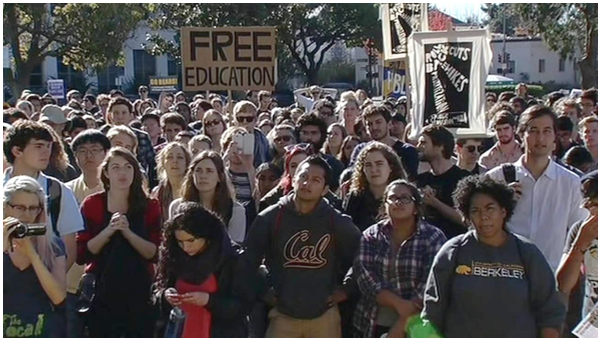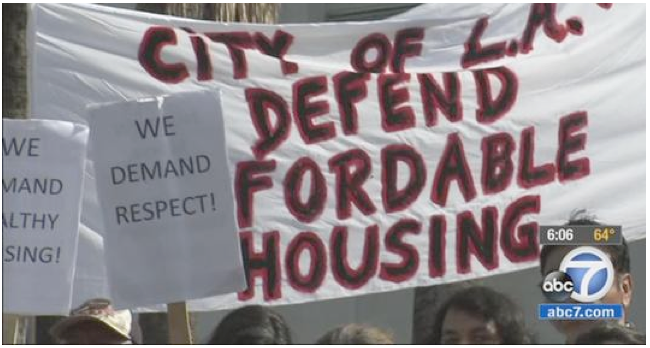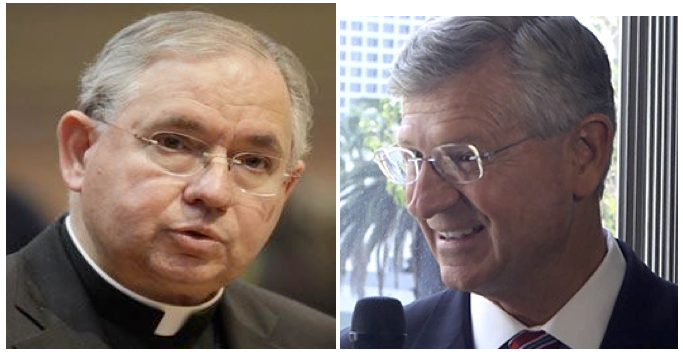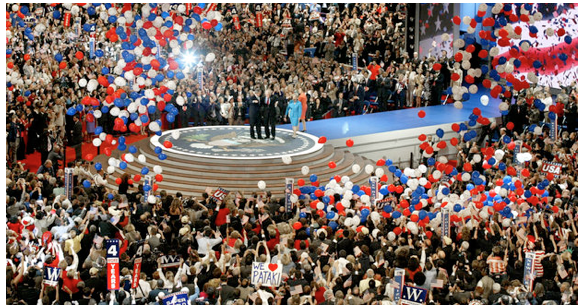On the Brink of Folly: Will City Council Unwittingly Upzone LA’s Single-Family Neighborhoods?
SECOND UNIT ALERT!--The City Council is poised to adopt an ordinance that would instantly double the potential density of every single-family residential neighborhood in the City of Los Angeles. The ordinance will give all property owners the ability to build “by right” a second house on their property of up to 1,200 square feet (equal to the size of many homes in Los Angeles) without any discretionary review. Of course, both the primary residence and the second unit houses can be rented. Overnight, every property zoned for one dwelling unit would be upzoned to permit two dwelling units. Amazingly, the City Council has reached this precipice with virtually no public input and with no CEQA analysis. (Photo above: illegal rental unit in Los Angeles.)
This impending decision poses two important questions for individual Council members: Will the City Council put the interests of a few hundred active second dwelling developers ahead of the hundreds of thousands of homeowners who have invested in and treasure the character of their single-family neighborhoods? And will the City Council make Los Angeles the first city in California to voluntarily surrender zoning authority over second dwelling development standards and subject itself to the State legislature’s control of those standards?
How did the City Council arrive at this brink? As is often the case at City Hall, it’s a combination of factors: spectacularly bad legal advice from the City Attorney, the Planning Department’s determination to shoehorn rental units into single-family neighborhoods, a strategic decision to “fast track” the process to avoid public participation, the failure of City Planning Commissioners and City Councilmembers to ask serious questions and the “group think” that often afflicts City Hall.
In order to understand the City Council’s impending decision, it is important to review the tortuous history of the City’s regulation of second dwelling units (SDUs):
The City Adopts A Balanced Approach to SDUs--Over 30 years ago, the City adopted a so-called “granny flat” ordinance (LAMC 12.24.W.43 and 12.24.W.44), which limited the floor area of an SDU to 640 square feet required compliance with height, setback and other requirements in the underlying zone, established constraints on a second unit’s visibility from the street, set a minimum lot size, mandated additional on-site parking and required a Conditional Use Permit (CUP). The purpose was to balance the desire for SDUs to house a family’s grown children, guests, or elderly parents with reasonable development standards and a CUP process to protect against possible adverse effects on the character of a single-family neighborhood. SDUs were prohibited in designated Hillside areas, equine-keeping areas and on substandard streets due to potential traffic congestion, parking problems and fire hazards.
The City Conforms to AB 1866’s Ministerial Processing Requirements--In 2002, the State legislature adopted AB 1866, which sought to encourage SDUs as a source of affordable rental housing. AB 1866 honored local control and recognized the continuing power of all California cities to establish and enforce their own development standards for SDUs. While AB 1866 prohibited cities from using discretionary CUP procedures and standards to review SDU applications, it made clear that cities were not required to amend their ordinances to rescind CUP requirements or discretionary factors.
Instead, cities could simply ignore those provisions and apply their development standards ministerially -- i.e., without public hearings and without any discretion to deny or mitigate second units and their impacts. If a City failed to adopt its own standards, then it would default to the more lenient State standards - the SDU could be up to 1,200 square feet in area, could be located in the back yard or front yard so long as existing zoning code requirements were met. AB 1866 also mandates that the SDU can be rented.
In 2003, then Chief Zoning Administrator Robert Janovici issued an administrative memorandum confirming that, in order to comply with AB 1866, the Planning Department and the Department of Building and Safety (LADBS) would ministerially grant building permits for SDUs that satisfy the City’s previously adopted second unit development standards.
The City’s Neighborhoods Reject Weakening Its SDU Standards--In 2009, the City Council asked the Planning Department to study whether the Zoning Code should be changed to weaken standards for SDUs. The Planning Department conducted extensive outreach to the City’s Neighborhood Councils and neighborhood associations. At hearings and workshops across the City, neighborhood representatives adamantly insisted that the City’s development standards should not be loosened. Then Planning Director Gail Goldberg advised the City Council that there was no support for changing the City’s standards for SDUs.
The City Attorney Gets It Wrong The First Time --In 2010, the City Attorney issued a surprising and incorrect legal opinion: that the City supposedly needed to formally amend its second unit ordinance to delete the discretionary CUP factors and the 2003 Janovici memorandum was legally insufficient to do this. Then-Chief Zoning Administrator Michael LoGrande dutifully complied, issuing a new directive (the now infamous ZA Memo 120) decreeing that the Planning Department and LADBS must implement the State’s lenient standards, which included approving any SDU up to 1,200 square feet. The City blindly followed the City Attorney’s bad advice and discarded its carefully developed second unit development standards.
With the post-recession housing recovery going into full swing, savvy Los Angeles developers realized that they could now purchase a single-family house as a rental property and, thanks to ZA Memo 120, receive a bonus: they could build and rent a 1,200 square foot second unit “by right” without any discretionary review! This windfall made speculation in single-family neighborhoods even more profitable: the developer could virtually double the rental income from a property by making a modest investment to build a second dwelling. The investor could now develop, on a “by right” basis, a multifamily rental property smack in the middle of what had been an owner-occupied, single-family neighborhood.
A Neighborhood Fights Back and the Court Agrees--When a property owner began constructing an oversized SDU on street frontage in Cheviot Hills in 2014, outraged neighbors formed an organization called Los Angeles Neighbors in Action, and sued the City to challenge the validity of ZA Memo 120.
In February 2016, the Superior Court agreed with the neighborhood and concluded that ZA Memo 120 was invalid. The Court ruled that the City Attorney was wrong when he concluded that the City must use the State default standards supposedly because the City’s ordinance had not been formally amended to delete the discretionary CUP provisions.
The Court also found that AB 1866 allows the City to continue to use its more stringent standards on a ministerial basis. The Court ordered the City to cease issuing building permits in reliance on ZA Memo 120 and to continue administering its existing development standards (i.e., a maximum 640 square feet and other development standards) on a ministerial basis until it takes further action to comply with AB 1866.
The Court also explained that the City has at least three choices to comply with its ruling. First, it can amend its existing ordinance to formally delete the discretionary CUP requirements and other discretionary factors. Second, by administrative memorandum, it can “sever” the discretionary aspects from the ordinance and apply the City development standards ministerially; i.e., it simply could reissue the 2003 Janovici memo. Finally, the City Council can repeal its SDU ordinance and default to the lenient State standards.
At this point, one might think that the City would want keep its own second unit development standards in place, if only to respect the desires of its neighborhoods that would be negatively affected by more SDUs. But never underestimate the power of bad legal advice in a City Hall that fails to ask tough questions.
The City Attorney Gets it Wrong – Again-- In a second instance of spectacularly bad legal advice from the City Attorney, coupled this time with bad policy recommendations from the Planning Department, City Hall determined that, after the Court rulings, the only “feasible” option available to the City would be to repeal the City’s SDU ordinance entirely, thereby subjecting the City to the State's lenient standards -- and potentially doubling the density of the City’s single family neighborhoods overnight!
Following closed door briefings of the City Council by the City Attorney, the Planning Department produced an ordinance in record time proposing to repeal its SDU standards and default to the State standards – becoming the only city in California ever to voluntarily abandon its right to set its own SDU development standards and surrender control to the State legislature. Of course, this means that if the State legislature loosens its default SDU standards further – say increasing the maximum area to 1,500 square feet or eliminating all off-street parking requirements – the relaxed standards will automatically apply throughout Los Angeles.
Shortly after the Court issued its ruling, LADBS put a hold on the hundreds of building permit applications in plan check. Astonishingly, LADBS even put a hold on SDU projects that fully satisfied the City’s existing development standards.
The City Attorney and the Planning Department Create a “Crisis” to Exploit-- Recognizing the adage that “You should never let a serious crisis go to waste,” the Planning Department and the City Attorney have created a crisis promoting the repeal ordinance on an “urgency” basis. Their explanation? Several hundred property owners and real estate investors who have SDUs in plan check or under construction must be grandfathered immediately to protect their interests!
The Planning Department packaged the repeal of the City’s SDU ordinance with the grandfathering of the pending projects as a single “urgency” ordinance and put it on the “fast track” to City Council approval. Amazingly, the City Attorney and Planning Department have never offered a legal justification or other reason why the repeal ordinance must be considered on an expedited basis, even if the stranded SDU projects deserve an “urgency” ordinance.
Not surprisingly, there is no legal justification for treating the repeal ordinance on an “urgency” basis. Of course, due to the Planning Department’s “fast track” approach, few Neighborhood Councils or neighborhood associations have had adequate time to learn about or voice their opinions on the proposed repeal.
What about the other two clear options offered by the Court in its decision? To the first option -- simply amending the City’s SDU ordinance to remove the CUP requirement and delete other discretionary factors -- the Planning Department fabricated an excuse that to do so would supposedly require public outreach and take a year or two, even though the amendment could be easily drafted and processed as quickly as the repeal ordinance.
To the second option -- simply reissuing the 2003 Janovici interpretation -- the Planning Department has pronounced an even weaker reply: the interpretation would somehow be inconsistent with the City’s Housing Element, despite the fact that the Housing Element does not require implementation of the State’s lenient standards.
By tying the repeal ordinance to the grandfathering provisions, the Planning Department has also activated a small but very vocal group to advocate for the repeal of the SDU ordinance: the several hundred homeowners and developers with SDU projects halted by LADBS. In no time, these homeowners and investors began calling Councilmembers demanding that the repeal of the SDU ordinances be expedited so that their projects can move forward!
The City Planning Commission and the PLUM Committee Blindly Follow--Things moved quickly from there. In what amounts to lightning speed for City Hall, the Planning Department produced a staff report and “urgent” repeal ordinance ready for the City Planning Commission on May 12, 2016. Despite the strong objections of the few homeowners associations that had become aware of the situation, the Planning Commissioners failed to ask any hard questions to keep the Planning Department honest and meekly followed the Department’s conclusion that there is no other option to repealing the SDU ordinance.
On June 7, 2016, the Planning and Land Use Management (PLUM) Committee also deferred to the incorrect advice of the Planning Department and City Attorney. To their credit, Councilmembers David Ryu and Nury Martinez presented testimony at the PLUM Committee hearing contending that the City should not abandon its residential neighborhoods and repeal its SDU ordinance. Both Councilmembers followed with letters formally opposing the repeal ordinance. Nevertheless, the PLUM Committee asked the City Attorney to produce a final repeal ordinance for City Council action.
Three weeks later, without any further public testimony or discussion, the PLUM Committee recommended approval of the repeal ordinance.
With the PLUM Committee approval, the final ordinance is teed up and ready for final City Council action as it reconvenes after its summer recess. This could be as soon as the last week in July or the first week in August.
The City Council Prepares to Make a Decision as Major Concerns Persist--The full City Council has not yet focused on the ramifications of its decision. There is still time for the Council to take a deep breath and then take a hard look at how the City Attorney and Planning Department have painted it into this corner. After numerous twists and turns, we have reached the final scene in this drama. Of course, the City Council can follow one of the other Court-recognized options to keep its SDU protections in place.
The following fascinating questions are presented:
- Will the City’s homeowners, neighborhood associations and Neighborhood Councils be able to make their voices heard?
- Will Councilmembers question the advice of the City Attorney and Planning Department that no option other than repeal is “feasible”? Will the City Council decide to pursue another option to maintain its SDU protections?
- Will Councilmembers question the Planning Department’s policy objective to promote the development of large SDUs on a “one size fits all” approach throughout Los Angeles’ single-family neighborhoods?
- Will the Councilmembers who represent Hillside areas realize that these neighborhoods will have no further meaningful protection from SDUs?
The last 10 years have been hard on Los Angeles’ single-family neighborhoods. First, the recession crushed housing prices and led to tens of thousands of foreclosures and homes converted to rental properties. The recession caused the City to reduce services to its single-family neighborhoods, as tree trimming, sidewalk replacement, road repaving and street sweeping became a thing of the past. Next came the density bonus for affordable housing, mansionization and the assault of Airbnb and other short-term rentals on otherwise quiet owner-occupied, single family neighborhoods.
The Planning Department’s current effort to promote rental housing in single-family neighborhoods, abetted by terrible ongoing advice from the City Attorney, leaves one wondering whether the City Council even understands the ramifications of its decisions, much less whether it really listens to or cares about its single-family neighborhoods.
But it is not too late for the City Council to step away from the brink. The Council can easily reject the Department’s proposed repeal ordinance and act to protect our single-family neighborhoods. For example, the Council can simply amend the SDU ordinance to keep the current protective standards while removing the discretionary CUP elements. Alternatively, the Council can decouple the grandfathering provisions to protect the reliance interests of property owners whose SDUs were stopped by LADBS and issue a new administrative memorandum that applies the existing SDU protections ministerially.
Anyone who cares about their neighborhood should call or email their Councilmember immediately to stop the repeal ordinance!
(Carlyle Hall is an environmental and land use lawyer in Los Angeles who founded the Center for Law in the Public Interest and litigated the well-known AB 283 litigation, in which the Superior Court ordered the City to rezone about one third of the properties within its territorial boundaries (an area the size of Chicago) to bring them into consistency with its 35 community plans. He also co-founded LA Neighbors in Action, which has recently been litigating with the City over its second dwelling unit policies and practices. Prepped for CityWatch by Linda Abrams.)














 I have grave concerns about a number of elements contained in the proposal plan… Several of the proposed features, including the 15- and 8-story towers, super signage and proposed new electronic sign district, are inappropriate and completely represent a break with the historical approach to development on this property. Massive 15-story office towers and lively bright electronic signage might be appropriate in a number of areas, however they do not have a place abutting a quiet, residential neighborhood.
I have grave concerns about a number of elements contained in the proposal plan… Several of the proposed features, including the 15- and 8-story towers, super signage and proposed new electronic sign district, are inappropriate and completely represent a break with the historical approach to development on this property. Massive 15-story office towers and lively bright electronic signage might be appropriate in a number of areas, however they do not have a place abutting a quiet, residential neighborhood.






















